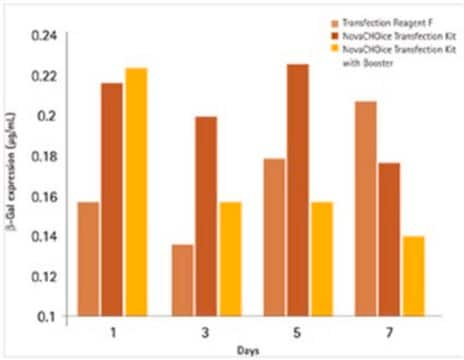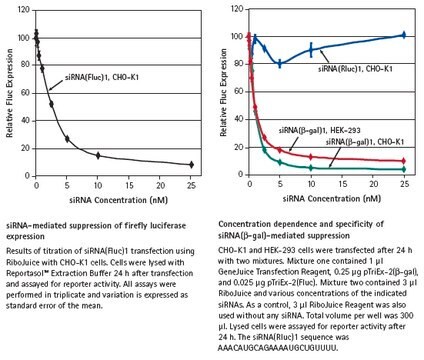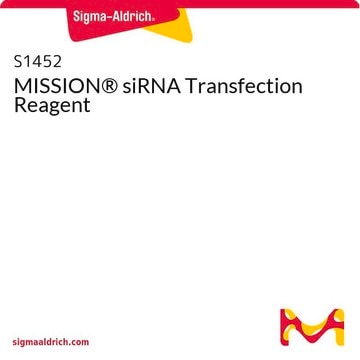Each Escort™ transfection Reagent is a different lipid formulation. These different formulations are more readily taken up by different cells, presumably by endocytosis.Escort™ III is a unique formulation of a proprietary polycationic lipid and a neutral, non-transfecting lipid.Escort™ IV is a a confidential lipid.
L3287
Escort™ IV Transfection Reagent
Lipid reagent for transient and stable transfection of mammalian and insect cells.
Synonym(s):
Gene delivery
About This Item
Recommended Products
grade
for molecular biology
Quality Level
form
liquid (aqueous solution)
usage
mL sufficient for 160-500 transfections
concentration
1 mg/mL
technique(s)
transfection: suitable
storage temp.
2-8°C
Related Categories
General description
Application
Features and Benefits
- Suitable for stable and transient transfection
- Optimized for a wide variety of cell lines
- Low toxicity
- Compatible with both serum and serum-free transfection protocols
- Ideal for Sf9, Sf21 and S2 insect cells
Components
1 mg/mL total lipid in water
Note the identity of the lipids used in Escort™ IV is confidential.
Caution
Principle
Legal Information
related product
Storage Class Code
10 - Combustible liquids
WGK
WGK 3
Flash Point(F)
Not applicable
Flash Point(C)
Not applicable
Personal Protective Equipment
Choose from one of the most recent versions:
Already Own This Product?
Find documentation for the products that you have recently purchased in the Document Library.
Customers Also Viewed
Articles
Transfection introduces genetic material into cells, aiding research in gene expression and cell biology.
Transfection introduces genetic material into cells, aiding research in gene expression and cell biology.
Transfection introduces genetic material into cells, aiding research in gene expression and cell biology.
Transfection introduces genetic material into cells, aiding research in gene expression and cell biology.
Protocols
The product bulletin providin detailed use protocol for easy DNA transfection.
Product manual provides detailed protocol for easy DNA transfection.
Universal Transfection Reagent enables efficient nucleic acid delivery into various cells, compatible with different cell culture conditions.
Universal Transfection Reagent enables efficient nucleic acid delivery into various cells, compatible with different cell culture conditions.
-
What are the differences between the two Escort™ products?
1 answer-
Helpful?
-
-
Is low cell passage number an important consideration for transfection?
1 answer-
Yes, we recommend cells are at a low passage when being used for any application, including transfection. The reason why depends on what type of cells they are. Primary cells will undergo a finite number of divisions, and as they get closer to senesence they divide more slowly - both affecting their ability to take up DNA (transient transfection), and minimizing their abillity to incorporate the DNA into the genome (stable selection).Cultured common cell lines are often immortalized, and generally continue to aquire mutations, leading to a heterogenous population that may perform differently from cells of lower passage number - leading to results that are not reproducible.
Helpful?
-
-
Is optimizing the transfection protocol important?
1 answer-
For many common cell lines, transfection reagent efficiency is very high and the protocols will not require any optimization. For hard-to-transfect cells or those ultimately expressing a toxic protein, the protocol should be optimized for best transfection efficiency. Taking time to optimize will give you more transfected cells with each procedure, which can mean more protein expressed and results that are reproducible.
Helpful?
-
-
Can antibiotics be present in the medium during transfection?
1 answer-
We recommend that no antibiotics are present during transfection. The process of transfection can make the cells somewhat more porous to allow for efficient DNA entry. During this time, antibiotics will also enter the cells more easily and the cells may show increased cell death. Wait until about 24 hours after transfection to resume the use of preventative antibiotics and/or start the use of selective antibiotics.
Helpful?
-
-
How can I increase the efficiency of my transfection?
1 answer-
Transfection efficiency is affected by many different things, including plasmid size and purity, media components present, transfection reagent selected, amount of DNA and transfection reagent used, cell density, etc. Optimizing the protocol with respect to these concerns will allow you to achieve a higher transfection efficiency. For many cell lines and transfection reagents, optimized protocols are already available.
Helpful?
-
-
What is transfection efficiency?
1 answer-
Transfection efficiency is a measure of how many cells take up the DNA during the transfection process. Many transfection reagents can achieve a transfection efficiency of >90% in common cell lines. Other cell lines are hard to transfect, and require special reagents and/or techniques to achieve even a small population of transfected cells.
Helpful?
-
-
Why do I see a precipitate in my cell culture after lipid-based transfection?
1 answer-
The precipitate is likely excess lipid or EDTA and will probablly not affect transfection efficiency. If your DNA plasmid is suspended in TE, be sure the concentration of EDTA is <0.3 mM, or suspend the DNA in sterile molecular biology grade water instead.
Helpful?
-
-
Can I transfect cells plated at low density?
1 answer-
For most transfections, cells should be >70% confluency the day of transfection, and growing in mid-log phase. Some transfection reagents are now designed to work with cells at low density, when required.
Helpful?
-
-
Is the size of the plasmid an important consideration for transfection?
1 answer-
The size of the plasmid should be considered when selecting a transfection reagent with the best efficiency. In general, larger sized plasmids should easily transfect with readily available transfection reagents, as along as the plasmid DNA is of high purity.
Helpful?
-
-
Which Escort™ transfection reagent should I use for my application?
1 answer-
Escort™ III is best for sensitive cells and primary cells, particularly PC-12 and Jurkat.Escort™ IV is excellent for mammalian cell lines, primary cells and insect cells.
Helpful?
-
Active Filters
Our team of scientists has experience in all areas of research including Life Science, Material Science, Chemical Synthesis, Chromatography, Analytical and many others.
Contact Technical Service











